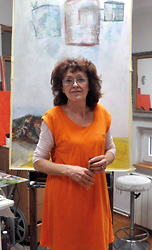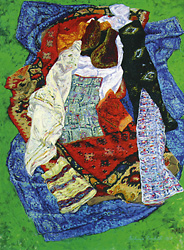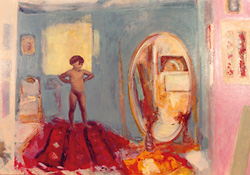Palette
LJUBICA RADOVIĆ, PAINTER FROM BELGRADE, PERSISTENTLY SEEKING MODERNITY OF THE PRIMORDIAL
Art Is a Dam Against Evil
In her paintings we see Adam and Eve, old Serbian webbings, clothing, flowers, landscapes from Boka, vedute of Dorćol, children, toys… She aesthetically goes back to the time of Matisse, Bonnard and Vuillard, however remains open for the experiences of Anselm Kiefer. She explores ancient Indo-European knowledge and symbols in the deepest layer of art, diving out into the heroic center of early Modernism. Similar to Proust, she seeks for higher states of happiness, maturity and wisdom
By: Dejan Đorić
 The life and work of painter Ljubica Buba Radović are hidden from the sound and the fury of the world after postmodern art. Living in the center of Belgrade, on the fifth floor without an elevator (like Emil Cioran), she, with her environment, life and art, created a dam against evil pervading and threatening to undermine not only her tower of beauty. Similar to old masters, retreated into the solitude of a fragrant and sunny studio visited only by the chosen ones, she reminds of great female artists and intellectuals between two world wars, those who celebrated the charms of civil culture. The life and work of painter Ljubica Buba Radović are hidden from the sound and the fury of the world after postmodern art. Living in the center of Belgrade, on the fifth floor without an elevator (like Emil Cioran), she, with her environment, life and art, created a dam against evil pervading and threatening to undermine not only her tower of beauty. Similar to old masters, retreated into the solitude of a fragrant and sunny studio visited only by the chosen ones, she reminds of great female artists and intellectuals between two world wars, those who celebrated the charms of civil culture.
The subjects and motifs from her paintings belong both to the traditional and the modern environment. She paints Adam and Eve, old Serbian webbings, ancient clothing, rugs, landscapes of Boka Kotorska, vedute with the nearby Church of Holy Alexander Nevsky, children and toys… Since recently, she has begun exploring the history of Western and Eastern art with her artistic language, without rejecting complex compositions of painting within painting and mirror painting. She is interested in the old and psychological meaning of color, pattern, ornament, sign and decoration. She was member of ”The Wall” drawing group which explored the structure of Kalemegdan and a wall as a poetic value.
RESTING ON HER OWN HERITAGE
 Vladimir Dvorniković, following the traces of Jovan Cvijić, determined in his Characterology of Yugoslavs that folk art of the Balkans has a symbolic and cosmic meaning, preserving the ancient Indo-European knowledge. The painter from Dorćol has always been interested in the ancient layer of fine arts; during her frequent journeys through Europe and North America, however, she got to know the contemporary flows, new stars of Western and Eastern art. Resting on her own heritage, she introduced both the traditional and the contemporary into paintings, watercolors, drawings, graphics and unique books, so she could be considered and extraordinary representative of modern traditionalism. Vladimir Dvorniković, following the traces of Jovan Cvijić, determined in his Characterology of Yugoslavs that folk art of the Balkans has a symbolic and cosmic meaning, preserving the ancient Indo-European knowledge. The painter from Dorćol has always been interested in the ancient layer of fine arts; during her frequent journeys through Europe and North America, however, she got to know the contemporary flows, new stars of Western and Eastern art. Resting on her own heritage, she introduced both the traditional and the contemporary into paintings, watercolors, drawings, graphics and unique books, so she could be considered and extraordinary representative of modern traditionalism.
 By painting landscapes, still life, male and female nudes, she, similar to Marcel Proust, seeks higher states of happiness, maturity and wisdom, the rare moments in which both the observer and the painter are pervaded with peace, when perfection is anticipated. Although a good drawer, from the circle around Dragan Lubarda, doyen and drawing professor, her abilities of expression are mostly found in coloring, painting full of light. Her craft, approach to the painting and matter, resolving artistic relations, have a lot of the heroic era of early modernism, from the time evil, ideological dependence and anti-art still didn’t penetrate creativity. She holds her brush firmly and watches the painting cautiously; knowing the value of each deposit, she weaves the facture with short, oblique moves. She returns the aesthetical to the time of Matisse, Bonnard and Vuillard, but also remains open for the experiences of Anselm Kiefer, pulling out into the foreground the noble, emotional drive of the world threatened by disintegration. As one of the last Serbian representatives of high modernism, she reminds of tradition and spiritual aristocracy. By painting landscapes, still life, male and female nudes, she, similar to Marcel Proust, seeks higher states of happiness, maturity and wisdom, the rare moments in which both the observer and the painter are pervaded with peace, when perfection is anticipated. Although a good drawer, from the circle around Dragan Lubarda, doyen and drawing professor, her abilities of expression are mostly found in coloring, painting full of light. Her craft, approach to the painting and matter, resolving artistic relations, have a lot of the heroic era of early modernism, from the time evil, ideological dependence and anti-art still didn’t penetrate creativity. She holds her brush firmly and watches the painting cautiously; knowing the value of each deposit, she weaves the facture with short, oblique moves. She returns the aesthetical to the time of Matisse, Bonnard and Vuillard, but also remains open for the experiences of Anselm Kiefer, pulling out into the foreground the noble, emotional drive of the world threatened by disintegration. As one of the last Serbian representatives of high modernism, she reminds of tradition and spiritual aristocracy.
STEADINESS OF THE WORLD OF FINE ARTS
 We must not, however, observe Ljubica Radović only as a heiress of great Serbian modernists educated between the two wars in Paris, Munich, Prague and Krakow. With her calm and solemn approach, she is before all the herald of good will, renewal of the positive attitude towards the painting, destroyed in post-avant-garde. As with Isidora Sekulić, joyful solitude that opens paths of thoughts towards wisdom stands above her entire opus, efforts, talent and work. We must not, however, observe Ljubica Radović only as a heiress of great Serbian modernists educated between the two wars in Paris, Munich, Prague and Krakow. With her calm and solemn approach, she is before all the herald of good will, renewal of the positive attitude towards the painting, destroyed in post-avant-garde. As with Isidora Sekulić, joyful solitude that opens paths of thoughts towards wisdom stands above her entire opus, efforts, talent and work.
 Having an education in Germanic studies, she is a pictor-doctus, educated painter, whose gentleness and humaneness are pervaded with the sharpness of in-depth analysis characteristic for the German spirit. Lessons of old masters are indirectly expressed in her work, more in the spiritual than in the vocational and technical sense. Her faithful audience, initiated by deeply personal reasons, always comes back to her with curiosity and the circle of those who respect her and collect her works is constantly spreading. Having an education in Germanic studies, she is a pictor-doctus, educated painter, whose gentleness and humaneness are pervaded with the sharpness of in-depth analysis characteristic for the German spirit. Lessons of old masters are indirectly expressed in her work, more in the spiritual than in the vocational and technical sense. Her faithful audience, initiated by deeply personal reasons, always comes back to her with curiosity and the circle of those who respect her and collect her works is constantly spreading.
Seemingly nothing is happening in the works of Ljubica Radović. Changes are slow and related to quality; there is nothing sensational or shocking, features that quickly take contemporary art into the category of tiring, boring and irritating. Exactly this is the pledge of peace and composure which, on a deeper level, can bring more surprises, joy and foundation. Behind the steadiness of the painter’s private and artistic world, before strength and cautiousness, stands the wisdom of an expert in life and art.
***
Path
 Ljubica Radović (Belgrade, 1950) graduated from the Academy of Fine Arts in Belgrade Department of Painting in 1976. As member of the Society of Fine Arts Artists of Serbia from 1977 on, she participated at many collective exhibitions in Yugoslavia, Norway, Greece, Bulgaria, France and Serbia. In 1984 she won the scholarship of the Greek government at the School of Fine Arts in Athens, Department of Graphics. In 1988 she participated in the graphics workshop ”Studio Nord” in Oslo, Norway. She held 32 solo exhibitions in Yugoslavia, Serbia, Germany and France. She is engaged in painting, drawing, graphics and bibliophilic publications. Ljubica Radović (Belgrade, 1950) graduated from the Academy of Fine Arts in Belgrade Department of Painting in 1976. As member of the Society of Fine Arts Artists of Serbia from 1977 on, she participated at many collective exhibitions in Yugoslavia, Norway, Greece, Bulgaria, France and Serbia. In 1984 she won the scholarship of the Greek government at the School of Fine Arts in Athens, Department of Graphics. In 1988 she participated in the graphics workshop ”Studio Nord” in Oslo, Norway. She held 32 solo exhibitions in Yugoslavia, Serbia, Germany and France. She is engaged in painting, drawing, graphics and bibliophilic publications.
|
